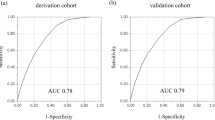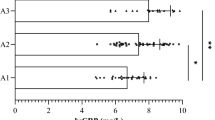Abstract
Background/Objectives:
Obesity, a chronic inflammatory state, increases risk of cardiovascular disease and insulin resistance, which are the leading cause of end-stage renal disease (ESRD). We evaluated the relationship between body mass index (BMI) and high-sensitivity C-reactive protein (hsCRP) level and impaired kidney function to determine the predictive value of both markers for estimating chronic kidney disease (CKD) risk in a healthy adult population in Taiwan.
Subjects/Methods:
In a retrospective cross-sectional study of 4100 subjects ⩾18 years, a multivariate logistic regression model was used to assess the relationship among BMI, high hsCRP levels and CKD. Receiver-operating characteristic curve and Youden index were developed to define the discrimination power of combining BMI with hsCRP for CKD prediction and to determine the best predictive index.
Results:
Overweight/obese subjects with high hsCRP levels had the highest odds ratio for CKD (P=0.048). In females, combining BMI with hsCRP for CKD prediction was superior to that of males (0.890 vs 0.623, respectively; both P<0.001). For females, the Youden index was 25.65 kg/m2 for BMI and 1.04 μg/ml for hsCRP.
Conclusions:
Overweight/obesity with higher hsCRP levels is associated with reduced renal function and increased risk for CKD. BMI and hsCRP levels can be used as surrogate markers for CKD risk, especially for females.
This is a preview of subscription content, access via your institution
Access options
Subscribe to this journal
Receive 12 print issues and online access
$259.00 per year
only $21.58 per issue
Buy this article
- Purchase on Springer Link
- Instant access to full article PDF
Prices may be subject to local taxes which are calculated during checkout

Similar content being viewed by others
References
Meguid El Nahas A, Bello AK . Chronic kidney disease: the global challenge. Lancet 2005; 365: 331–340.
Manson JE, Colditz GA, Stampfer MJ, Willett WC, Rosner B, Monson RR et al. A prospective study of obesity and risk of coronary heart disease in women. N Engl J Med 1990; 322: 882–889.
Go AS, Chertow GM, Fan D, McCulloch CE, Hsu CY . Chronic kidney disease and the risks of death, cardiovascular events, and hospitalization. N Engl J Med 2004; 351: 1296–1305.
Wen CP, Cheng TY, Tsai MK, Chang YC, Chan HT, Tsai SP et al. All-cause mortality attributable to chronic kidney disease: a prospective cohort study based on 462 293 adults in Taiwan. Lancet 2008; 371: 2173–2182.
Willett WC, Manson JE, Stampfer MJ, Colditz GA, Rosner B, Speizer FE et al. Weight, weight change, and coronary heart disease in women. Risk within the 'normal' weight range. JAMA 1995; 273: 461–465.
Haroun MK, Jaar BG, Hoffman SC, Comstock GW, Klag MJ, Coresh J . Risk factors for chronic kidney disease: a prospective study of 23,534 men and women in Washington County, Maryland. J Am Soc Nephrol 2003; 14: 2934–2941.
Fox CS, Larson MG, Leip EP, Culleton B, Wilson PW, Levy D . Predictors of new-onset kidney disease in a community-based population. JAMA 2004; 291: 844–850.
Collins AJ, Foley RN, Chavers B, Gilbertson D, Herzog C, Ishani A et al. US Renal Data System 2013 Annual Data Report. Am J Kidney Dis 2014; 63, (Suppl 1) A7.
Hsu CY, McCulloch CE, Iribarren C, Darbinian J, Go AS . Body mass index and risk for end-stage renal disease. Ann Intern Med 2006; 144: 21–28.
Foster MC, Hwang SJ, Larson MG, Lichtman JH, Parikh NI, Vasan RS et al. Overweight, obesity, and the development of stage 3 CKD: the Framingham Heart Study. Am J Kidney Dis 2008; 52: 39–48.
Fogo AB . Mechanisms of progression of chronic kidney disease. Pediatr Nephrol 2007; 22: 2011–2022.
Qian Y, Feldman E, Pennathur S, Kretzler M, Brosius FC III . From fibrosis to sclerosis: mechanisms of glomerulosclerosis in diabetic nephropathy. Diabetes 2008; 57: 1439–1445.
Dalla Vestra M, Mussap M, Gallina P, Bruseghin M, Cernigoi AM, Saller A et al. Acute-phase markers of inflammation and glomerular structure in patients with type 2 diabetes. J Am Soc Nephrol 2005; 16, (Suppl 1) S78–S82.
Ejerblad E, Fored CM, Lindblad P, Fryzek J, McLaughlin JK, Nyren O . Obesity and risk for chronic renal failure. J Am Soc Nephrol 2006; 17: 1695–1702.
Iseki K, Ikemiya Y, Kinjo K, Inoue T, Iseki C, Takishita S . Body mass index and the risk of development of end-stage renal disease in a screened cohort. Kidney Int 2004; 65: 1870–1876.
Mora S, Musunuru K, Blumenthal RS . The clinical utility of high-sensitivity C-reactive protein in cardiovascular disease and the potential implication of JUPITER on current practice guidelines. Clin Chem 2009; 55: 219–228.
Pearson TA, Mensah GA, Alexander RW, Anderson JL, Cannon RO III, Criqui M et al. Markers of inflammation and cardiovascular disease: application to clinical and public health practice: A statement for healthcare professionals from the Centers for Disease Control and Prevention and the American Heart Association. Circulation 2003; 107: 499–511.
National Kidney F. K/DOQI clinical practice guidelines for chronic kidney disease: evaluation, classification, and stratification. Am J Kidney Dis 2002; 39: S1–S266.
Couser WG . Chronic kidney disease the promise and the perils. J Am Soc Nephrol 2007; 18: 2803–2805.
Choo V . WHO reassesses appropriate body-mass index for Asian populations. Lancet 2002; 360: 235.
WHO/IASO/IOTF. The Asia-Pacific Perspective: Redefining Obesity and its Treatment. Health Communications Australia Pty Ltd: Balmain, NSW, Australia, 2000.
The International Diabetes Federation consensus of worldwide definition of the metabolic syndrome, 2006. The website of the International Diabetes Federation. www.idf.org/metabolic_syndrome.
Ma YC, Zuo L, Chen JH, Luo Q, Yu XQ, Li Y et al. Modified glomerular filtration rate estimating equation for Chinese patients with chronic kidney disease. J Am Soc Nephrol 2006; 17: 2937–2944.
National Cholesterol Education Program Expert Panel on Detection E, Treatment of High Blood Cholesterol in A. Third Report of the National Cholesterol Education Program (NCEP) Expert Panel on Detection, Evaluation, and Treatment of High Blood Cholesterol in Adults (Adult Treatment Panel III) final report. Circulation 2002; 106: 3143–3421.
Chen S, Liu H, Liu X, Li Y, Li M, Liang Y et al. Central obesity, C-reactive protein and chronic kidney disease: a community-based cross-sectional study in southern China. Kidney Blood Press Res 2013; 37: 392–401.
Gregor MF, Hotamisligil GS . Inflammatory mechanisms in obesity. Annu Rev Immunol 2011; 29: 415–445.
Kalil GZ, Haynes WG . Sympathetic nervous system in obesity-related hypertension: mechanisms and clinical implications. Hypertens Res 2012; 35: 4–16.
Wahba IM, Mak RH . Obesity and obesity-initiated metabolic syndrome: mechanistic links to chronic kidney disease. Clin J Am Soc Nephrol 2007; 2: 550–562.
Bagby SP . Obesity-initiated metabolic syndrome and the kidney: a recipe for chronic kidney disease? J Am Soc Nephrol 2004; 15: 2775–2791.
Helal I, Fick-Brosnahan GM, Reed-Gitomer B, Schrier RW . Glomerular hyperfiltration: definitions, mechanisms and clinical implications. Nat Rev Nephrol 2012; 8: 293–300.
Levine DZ . Can rodent models of diabetic kidney disease clarify the significance of early hyperfiltration?: recognizing clinical and experimental uncertainties. Clin Sci 2008; 114: 109–118.
Rabe K, Lehrke M, Parhofer KG, Broedl UC . Adipokines and insulin resistance. Mol Med 2008; 14: 741–751.
Yang X, Smith U . Adipose tissue distribution and risk of metabolic disease: does thiazolidinedione-induced adipose tissue redistribution provide a clue to the answer? Diabetologia 2007; 50: 1127–1139.
Kern PA, Ranganathan S, Li C, Wood L, Ranganathan G . Adipose tissue tumor necrosis factor and interleukin-6 expression in human obesity and insulin resistance. Am J Physiol Endocrinol Metab 2001; 280: E745–E751.
Tsigos C, Kyrou I, Chala E, Tsapogas P, Stavridis JC, Raptis SA et al. Circulating tumor necrosis factor alpha concentrations are higher in abdominal versus peripheral obesity. Metabolism 1999; 48: 1332–1335.
Hotamisligil GS, Arner P, Caro JF, Atkinson RL, Spiegelman BM . Increased adipose tissue expression of tumor necrosis factor-alpha in human obesity and insulin resistance. J Clin Invest 1995; 95: 2409–2415.
Hotamisligil GS, Shargill NS, Spiegelman BM . Adipose expression of tumor necrosis factor-alpha: direct role in obesity-linked insulin resistance. Science 1993; 259: 87–91.
Navarro JF, Milena FJ, Mora C, Leon C, Garcia J . Renal pro-inflammatory cytokine gene expression in diabetic nephropathy: effect of angiotensin-converting enzyme inhibition and pentoxifylline administration. Am J Nephrol 2006; 26: 562–570.
Gupta J, Mitra N, Kanetsky PA, Devaney J, Wing MR, Reilly M et al. Association between albuminuria, kidney function, and inflammatory biomarker profile in CKD in CRIC. Clin J Am Soc Nephrol 2012; 7: 1938–1946.
Musunuru K, Kral BG, Blumenthal RS, Fuster V, Campbell CY, Gluckman TJ et al. The use of high-sensitivity assays for C-reactive protein in clinical practice. Nat Clin Pract Cardiovasc Med 2008; 5: 621–635.
Danesh J, Wheeler JG, Hirschfield GM, Eda S, Eiriksdottir G, Rumley A et al. C-reactive protein and other circulating markers of inflammation in the prediction of coronary heart disease. N Engl J Med 2004; 350: 1387–1397.
Inker LA, Astor BC, Fox CH, Isakova T, Lash JP, Peralta CA et al. KDOQI US commentary on the 2012 KDIGO clinical practice guideline for the evaluation and management of CKD. Am J Kidney Dis 2014; 63: 713–735.
Stuveling EM, Hillege HL, Bakker SJ, Gans RO, De Jong PE, De Zeeuw D . C-reactive protein is associated with renal function abnormalities in a non-diabetic population. Kidney Int 2003; 63: 654–661.
Deurenberg P, Yap M, van Staveren WA . Body mass index and percent body fat: a meta analysis among different ethnic groups. Int J Obes Relat Metab Disord 1998; 22: 1164–1171.
Pan WH, Flegal KM, Chang HY, Yeh WT, Yeh CJ, Lee WC . Body mass index and obesity-related metabolic disorders in Taiwanese and US whites and blacks: implications for definitions of overweight and obesity for Asians. Am J Clin Nutr 2004; 79: 31–39.
Tsai YW, Ho CI, Chen JY, Chang KC, Weng YM, Chen SY et al. Impact of body composition on estimated glomerular filtration rate in relatively healthy adults in Taiwan. Eur J Clin Nutr 2015; 69: 34–39.
Whaley-Connell AT, Sowers JR, Stevens LA, McFarlane SI, Shlipak MG, Norris KC et al. CKD in the United States: Kidney Early Evaluation Program (KEEP) and National Health and Nutrition Examination Survey (NHANES) 1999–2004. Am J Kidney Dis 2008; 51: S13–S20.
Author information
Authors and Affiliations
Corresponding author
Ethics declarations
Competing interests
The authors declare no conflict of interest.
Rights and permissions
About this article
Cite this article
Tsai, YW., Lu, MC., Lin, YH. et al. Combined body mass index with high-sensitivity C-reactive protein as independent predictors for chronic kidney disease in a relatively healthy population in Taiwan. Eur J Clin Nutr 70, 766–771 (2016). https://doi.org/10.1038/ejcn.2016.28
Received:
Revised:
Accepted:
Published:
Issue Date:
DOI: https://doi.org/10.1038/ejcn.2016.28



